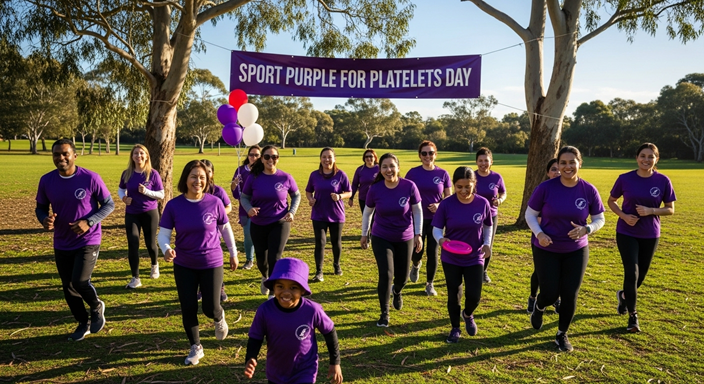Every year, Sport Purple for Platelets Day reminds the #world of the importance of raising awareness for #ITP (Immune Thrombocytopenia), a rare autoimmune #bleeding #disorder that affects the body’s platelet count. By wearing #purple, participating in #events, and #spreading the word, #individuals and #communities come together to show support for those living with ITP and their families. This day serves as a unifying force that brings #strength, #knowledge, and #compassion to people who might otherwise feel isolated in their struggles. #SportPurpleForPlateletsDay is more than just a campaign—it’s a global call for #awareness, #research, and #solidarity.
History of Sport Purple for Platelets Day
The origins of Sport Purple for Platelets Day date back to 2010, when the Platelet Disorder Support Association (PDSA) initiated this awareness campaign. The idea was simple yet impactful: dedicate one day each year when communities, schools, organizations, and individuals would wear purple and participate in awareness-driven activities to highlight the challenges faced by those with ITP.
The PDSA, founded in 1998 by Joan Young, played a pivotal role in bringing attention to this rare disorder. Joan herself was an ITP patient and recognized the lack of awareness and research funding for platelet-related conditions. Her efforts, alongside many volunteers, led to the creation of this awareness day. Over time, the event grew globally, with countries around the world embracing purple as a symbol of strength, resilience, and unity against platelet disorders.
Importance of Sport Purple for Platelets Day
The importance of Sport Purple for Platelets Day lies in its ability to:
-
Raise Awareness – ITP often goes unnoticed due to its rarity. A dedicated day helps spotlight the disorder.
-
Encourage Diagnosis – Increased knowledge allows individuals to seek timely medical intervention.
-
Support Research – Awareness campaigns drive fundraising efforts for better treatments and potential cures.
-
Build Communities – Patients and families find comfort in connecting with others experiencing similar challenges.
-
Advocate for Patients – Highlighting the struggles of ITP patients helps push for healthcare improvements, better insurance coverage, and greater medical understanding.
Without such observances, many would remain unaware of the daily realities faced by those living with platelet disorders.
Significance of Sport Purple for Platelets Day
The significance of Sport Purple for Platelets Day goes beyond just raising awareness. It serves as:
-
A Symbol of Hope – Purple represents dignity, courage, and healing, which is what patients need on their journeys.
-
A Call for Action – The day urges governments, NGOs, and medical communities to prioritize platelet disorder research.
-
A Platform for Stories – Patients share their personal experiences, making the world more empathetic and compassionate.
-
A Community Movement – Friends, families, and healthcare providers unite under one cause, creating a support system for those who often feel alone.
It’s not just a day of awareness—it’s a movement toward change.
Why Sport Purple for Platelets Day Is Celebrated
Sport Purple for Platelets Day is celebrated to shine a light on:
-
The challenges faced by ITP patients, including fatigue, bruising, and internal bleeding risks.
-
The urgent need for more medical research and funding.
-
The power of collective compassion, where communities come together to show patients that they are not fighting alone.
-
Breaking the stigma around rare diseases by normalizing conversations about ITP and other platelet-related disorders.
It is celebrated to remind the world that every platelet counts—not only medically, but symbolically too.
How Sport Purple for Platelets Day Is Celebrated?
The celebration of Sport Purple for Platelets Day is vibrant, creative, and deeply heartfelt. Some common ways it is observed include:
-
Wearing Purple – People wear purple clothes, accessories, or ribbons to show solidarity.
-
Community Events – Walkathons, charity runs, and awareness marathons are organized.
-
Fundraising Drives – Donations are collected to support research and patient support initiatives.
-
Educational Campaigns – Hospitals, schools, and organizations host talks and workshops on ITP.
-
Social Media Movements – People share posts, stories, and photos using hashtags like #SportPurpleForPlateletsDay.
-
Lighting Landmarks Purple – In some cities, iconic buildings are illuminated in purple to spread awareness.
-
Creative Expressions – Art contests, storytelling sessions, and music events are organized to inspire participation.
The spirit of the day is to engage people meaningfully, whether through small gestures or large-scale campaigns.
Countries Where It Is Celebrated
Although initiated in the United States, Sport Purple for Platelets Day has spread to many other parts of the world. Today, it is celebrated in:
-
United States – The birthplace of the campaign, where PDSA continues to lead initiatives.
-
Canada – Actively celebrates with community-based events.
-
United Kingdom – Awareness campaigns and educational programs are conducted.
-
Australia – Local health groups and communities participate in purple events.
-
European Nations – Several countries in Europe join in solidarity through hospitals and patient groups.
-
Asia – Slowly gaining recognition, with patient groups in India and Japan joining the awareness drive.
The movement continues to grow as global health networks emphasize the importance of rare disease awareness.
How Citizens Involve Themselves and Make It a Success
The success of Sport Purple for Platelets Day relies heavily on citizen participation. People get involved by:
-
Wearing Purple Outfits at workplaces, schools, or homes.
-
Sharing Patient Stories on social media to educate their networks.
-
Organizing Community Fundraisers like bake sales, charity concerts, or auctions.
-
Volunteering for Local Events hosted by health organizations.
-
Educating Children about rare diseases through schools and workshops.
-
Donating directly to PDSA or local platelet disorder research organizations.
-
Encouraging Healthcare Providers to talk more openly about ITP with patients.
Each act, big or small, makes a huge difference. Citizens transform awareness into a movement, ensuring that the voices of ITP patients are heard.
Theme for Sport Purple for Platelets Day 2025
Each year, Sport Purple for Platelets Day adopts a theme that guides its campaigns and events. For 2025, the proposed theme is:
“United in Purple: Every Platelet Counts”
This theme highlights the importance of unity in the fight against ITP. It emphasizes collective strength—patients, families, researchers, doctors, and communities working hand in hand to improve lives. It’s not just about awareness—it’s about building a strong, global community.
10 Famous Quotes for Sport Purple for Platelets Day
-
“Awareness is the first step toward change.”
-
“Every platelet tells a story of strength and resilience.”
-
“Wearing purple is not just a color choice—it’s a promise of support.”
-
“Together, we are stronger than ITP.”
-
“One voice can start a ripple, but many voices create a wave.”
-
“Hope shines brightest when we unite in purple.”
-
“No one fights alone—community is the cure for isolation.”
-
“Rare doesn’t mean invisible; awareness makes us seen.”
-
“Research begins with awareness, and awareness begins with us.”
-
“Purple is more than a color—it’s a symbol of life and courage.”
Frequently Asked Questions (FAQs)
Q1: What is Sport Purple for Platelets Day?
It is a global awareness day dedicated to highlighting Immune Thrombocytopenia (ITP), a rare autoimmune platelet disorder.
Q2: When is Sport Purple for Platelets Day observed?
It is observed annually on the last Friday of September.
Q3: Who started Sport Purple for Platelets Day?
The day was started in 2010 by the Platelet Disorder Support Association (PDSA).
Q4: Why do people wear purple on this day?
Purple symbolizes strength, courage, and dignity. Wearing purple shows solidarity with ITP patients.
Q5: What does ITP stand for?
ITP stands for Immune Thrombocytopenia, a rare disorder where the immune system destroys healthy platelets.
Q6: How common is ITP?
ITP is considered a rare disease, affecting about 3 to 4 per 100,000 adults annually.
Q7: What are the main symptoms of ITP?
Symptoms include easy bruising, prolonged bleeding, fatigue, and in severe cases, internal bleeding.
Q8: How can I participate in Sport Purple for Platelets Day?
You can wear purple, attend events, donate, or spread awareness on social media.
Q9: Is Sport Purple for Platelets Day recognized globally?
Yes, while it began in the US, many countries now observe it to spread awareness about ITP.
Q10: Why is raising awareness about ITP important?
Because awareness leads to earlier diagnoses, better treatments, increased research funding, and more support for patients.
Conclusion
Sport Purple for Platelets Day is more than a symbolic celebration—it is a lifeline for patients, a spark for researchers, and a reminder for the world that rare diseases deserve recognition. By wearing purple, sharing stories, and participating in events, we ensure that ITP patients are not fighting their battles alone.
The 2025 theme, “United in Purple: Every Platelet Counts,” calls upon each of us to play our part in creating a stronger, more informed, and compassionate world. Together, in unity and awareness, we can transform purple into a global beacon of hope.
|
!!! Stay Updated !!! 👉 Follow and Join us on 👈 📰 Trending News | 📢 Important Alerts | 💼 Latest Jobs LinkedIn | Threads | Facebook |Instagram | Tumblr 📱 Follow us daily & never miss an update 📱 |

Someshwar Chowdhury is a seasoned Chartered Mechanical Engineer, Educator, and Technology enthusiast with over a decade of experience in engineering education and consultancy. Someshwar is also an active blogger, trainer, and member of professional bodies like ISHRAE and GREEN ADD+. When not teaching or consulting, he enjoys blogging, music, and exploring green technologies.
Discover more from Today's Significance
Subscribe to get the latest posts sent to your email.
